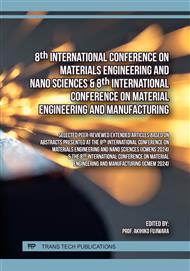[1]
N. Moes, J. Dolbow, and T. Belytschko, "A finite element method for crack growth without remeshing," Int. J. Numer. Methods Eng., vol. 46, no. February, p.131–150, 1999.
DOI: 10.1002/(sici)1097-0207(19990910)46:1<131::aid-nme726>3.3.co;2-a
Google Scholar
[2]
N. Sukumar, N. Moes, B. Moran, and T. Belytschko, "Extended finite element method for three-dimensional crack modelling," Int. J. Numer. Methods Eng., vol. 46, no. November 1999, p.1549–1570, 2000.
DOI: 10.1002/1097-0207(20000820)48:11<1549::aid-nme955>3.0.co;2-a
Google Scholar
[3]
V. Sonkar, S. Bhattacharya, and K. Sharma, "A Three Dimensional Fracture Analysis of an Edge Crack in FGM Using XFEM," Mater. Sci. Forum, vol. 969, p.315–320, 2019.
DOI: 10.4028/www.scientific.net/MSF.969.315
Google Scholar
[4]
V. Sonkar, S. Bhattacharya, and K. Sharma, "Simulation of edge cracked 3D functionally graded domain using XFEM," AIP Conf. Proc., vol. 2273, no. 1, p.50017, 2020.
DOI: 10.1063/5.0024379
Google Scholar
[5]
V. Sonkar, S. Bhattacharya, and K. Sharma, "XFEM Simulation of an Edge Cracked 3D Functionally Graded Cuboid," AIP Conf. Proc., vol. 2220, no. 1, p.140001, 2020.
DOI: 10.1063/5.0001785
Google Scholar
[6]
V. Sonkar, S. Bhattacharya, and K. Sharma, "Numerical Simulation of Three Dimensional Fracture Mechanics Problems of Functionally Graded Pipe and Pipe Bend Using XFEM," Iran. J. Sci. Technol. Trans. Mech. Eng., vol. 46, no. 4, p.1031–1045, 2022.
DOI: 10.1007/s40997-021-00470-0
Google Scholar
[7]
V. Sonkar, S. Bhattacharya, and K. Sharma, "Three dimensional extended finite element simulation of cracked functionally graded pipe and pipe bend," Proc. Inst. Mech. Eng. Part C J. Mech. Eng. Sci., vol. 236, no. 16, p.9124–9137, 2022.
DOI: 10.1177/09544062221091522
Google Scholar
[8]
T. Nagashima, Y. Omoto, and S. Tani, "Stress intensity factor analysis of interface cracks using X-FEM," Int. J. Numer. Methods Eng., vol. 56, no. 8, p.1151–1173, 2003.
DOI: 10.1002/nme.604
Google Scholar
[9]
N. Sukumar, Z. Y. Huang, J. Prévost, and Z. Suo, "Partition of unity enrichment for bimaterial interface cracks," Int. J. Numer. Methods Eng., vol. 59, no. 8, p.1075–1102, 2004.
DOI: 10.1002/nme.902
Google Scholar
[10]
H. Yu, L. Wu, L. Guo, Q. He, and S. Du, "Interaction integral method for the interfacial fracture problems of two nonhomogeneous materials," Mech. Mater., vol. 42, no. 4, p.435–450, 2010.
DOI: 10.1016/j.mechmat.2010.01.001
Google Scholar
[11]
S. Bhattacharya, I. V Singh, B. K. Mishra, and T. Q. Bui, "Fatigue crack growth simulations of interfacial cracks in bi-layered FGMs using XFEM," Comput. Mech., vol. 52, p.799–814, 2013.
DOI: 10.1007/s00466-013-0845-8
Google Scholar
[12]
H. Pathak, A. Singh, I. V. Singh, and S. K. Yadav, "A simple and efficient XFEM approach for 3-D cracks simulations," Int. J. Fract., vol. 181, no. 2, p.189–208, 2013.
DOI: 10.1007/s10704-013-9835-2
Google Scholar
[13]
M. Gosz, J. Dolbow, and B. Moran, "Domain integral formulation for stress intensity factor computation along curved three-dimensional interface," Int. J. Solids Struct., vol. 35, no. 15, p.1763–1783, 1998.
DOI: 10.1016/S0020-7683(97)00132-7
Google Scholar
[14]
B. N. Rao and S. Rahman, "An interaction integral method for analysis of cracks in orthotropic functionally graded materials," Comput. Mech., vol. 32, p.40–51, 2003.
DOI: 10.1007/s00466-003-0460-1
Google Scholar



